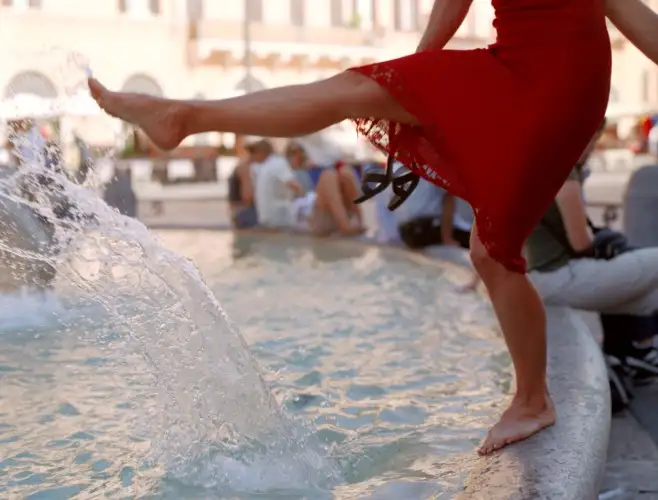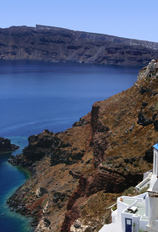
What doesn’t change about Italy is that it’s always changing. In 2012 some long-closed doors are opening again. Historic sights, newly scrubbed and restored, are coming out from behind scaffolding. A few more monuments are still under wraps, but getting closer to completion. Italy is revealing itself anew (or molting).
In Rome, the Colosseum is being cleaned from top to bottom and given permanent lighting. For the first time, tours are being offered to previously restricted areas—underground passageways and the third-floor parapet. This behind-the-scenes tour is available only by booking a 90-minute tour at least a day in advance with Pierrici, a private company.
At Rome’s Palatine Hill, you can now tour the House of Livia, the home of the wife of Emperor Augustus. Guided visits, which are included with admission, take 20 people every half-hour to tour the site and its newly restored frescoes. As surviving Roman wall paintings are rare (these date back to the first century B.C.), it’s worth the trouble.
A few doors are better left closed: Rome’s Mamertine Prison is no longer worth a visit. Until recently, it was a charming and historic sight. Today its artifacts have been removed, and a commercial tour-bus company is charging €10 for a cheesy “multimedia” walk-through. Don’t go in. And avoid getting sucked in by the clever advertising for the Time Elevator Roma or the hype surrounding the new, inconveniently located MAXXI modern-art museum, which to me comes off like a second-rate Pompidou Center.
At St. Peter’s Basilica, you won’t have to descend into the crypt to find the tomb of the late, beloved Pope John Paul II. After he was beatified on May 1 (bringing him a step closer to sainthood), his remains were moved to the Chapel of San Sebastian on the main floor on the basilica (midway between Michelangelo’s Pieta and the main altar).
In Venice, as renovations continue at the Accademia—showcasing the city’s top collection of Venetian paintings—some major canvases are out of view and some rooms are closed entirely. There’s still scaffolding around the base of the Campanile, the dramatic bell tower on St. Mark’s Square, but a three-year restoration of the lovely little Bridge of Sighs—popular with romantics who kiss as they glide under it on a gondola—is now complete.
In Florence the big news for visitors is the energetic young mayor’s passion for traffic-free zones. Once brutal for pedestrians, the city’s core is now a delight on foot. That means it’s also more bike-friendly, and you’ll find appealing city bike tours and bike rental services readily available.
Florence also now offers a new sightseeing pass called the Florence Card (€50). Though it’s unlikely to save you much money, it saves you the hassle of making reservations for the top sights (Uffizi and Accademia galleries), and—most important—allows you to bypass the long lines. The card is valid for 72 hours, includes most sights, and covers free use of city buses. Especially if you’ll be seeing five or six major sights within three days, the pass is worth it for the convenience and the time saved.
At Florence’s Duomo Museum, the restoration of the original panels of Ghiberti’s Gates of Paradise is wrapping up. The famous panels are being reinserted in their door frames and should be back on display for a formal inauguration on June 24, 2012, the feast day of Florence’s patron saint, John the Baptist. And Florence’s Galileo Science Museum, which was in a jumble of restoration for years, is now all fixed up and ready for prime time.
Sadly, the biggest change in Italy for 2012 is the result of a natural disaster. When I was in the magical towns of the Cinque Terre in May 2011, I never could have imagined that, just a few months later, the streets I walked on would be under more than six feet of mud and rocks, devastated by a horrific flash flood.
Of the five towns of the Cinque Terre, the two most popular towns for tourists—Vernazza and Monterosso—were hit hard. Monterosso plans to be ready for business in the spring of 2012, but Vernazza’s road to recovery will take longer. At ricksteves.com, we’re host a landing page with updates, travel information, and hotlinks to organizations accepting donations to aid the town’s recovery.
In spite of the damage and disruption, I’m already making plans to visit the Cinque Terre in 2012 and expect to have a wonderful Riviera experience. The strong spirit of its people and the love of its many honorary citizens—the legions of visitors, like me, who have left a piece of their hearts there—will ensure that the Cinque Terre will rebuild.
Rick Steves (www.ricksteves.com)writes European travel guidebooks and hosts travel shows on public television and public radio. Email him at [email protected] and follow his blog on Facebook.
We hand-pick everything we recommend and select items through testing and reviews. Some products are sent to us free of charge with no incentive to offer a favorable review. We offer our unbiased opinions and do not accept compensation to review products. All items are in stock and prices are accurate at the time of publication. If you buy something through our links, we may earn a commission.
Related
Top Fares From
Today's Top Travel Deals
Brought to you by ShermansTravel
Greece: 9-Night Vacation, Incl. Meteora &...
Exoticca
 vacation
$2099+
vacation
$2099+
New Year Sale: Luxe, 9-Nt Alaska...
Oceania Cruises
 cruise
$3599+
cruise
$3599+
Ohio: Daily Car Rentals from Cincinnati
85OFF.com
 Car Rental
$19+
Car Rental
$19+



